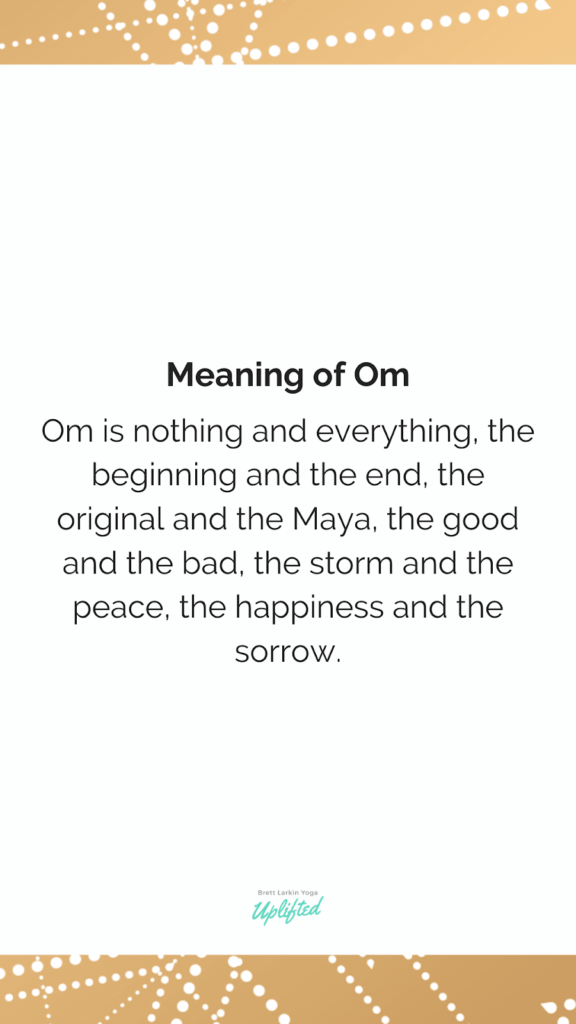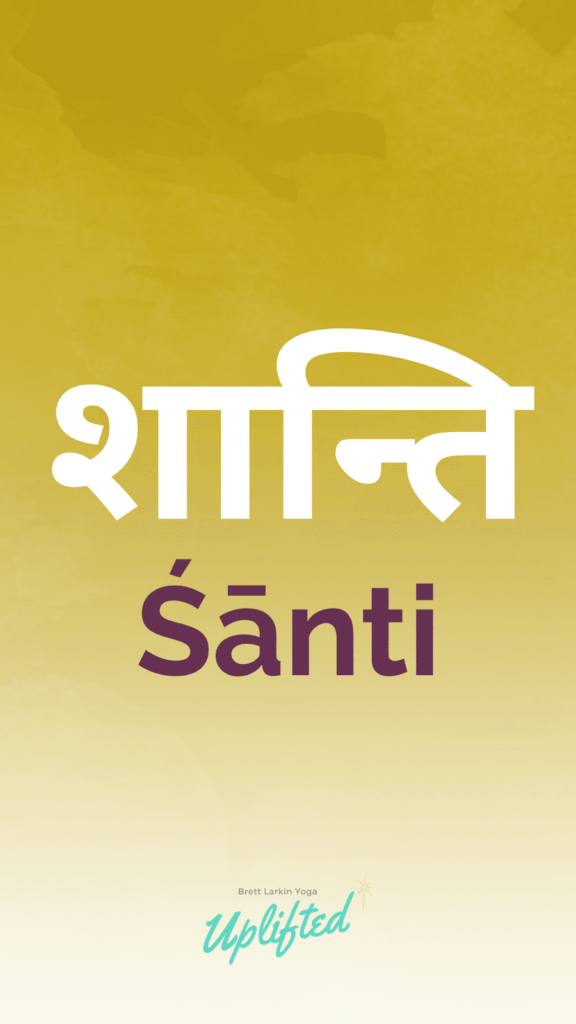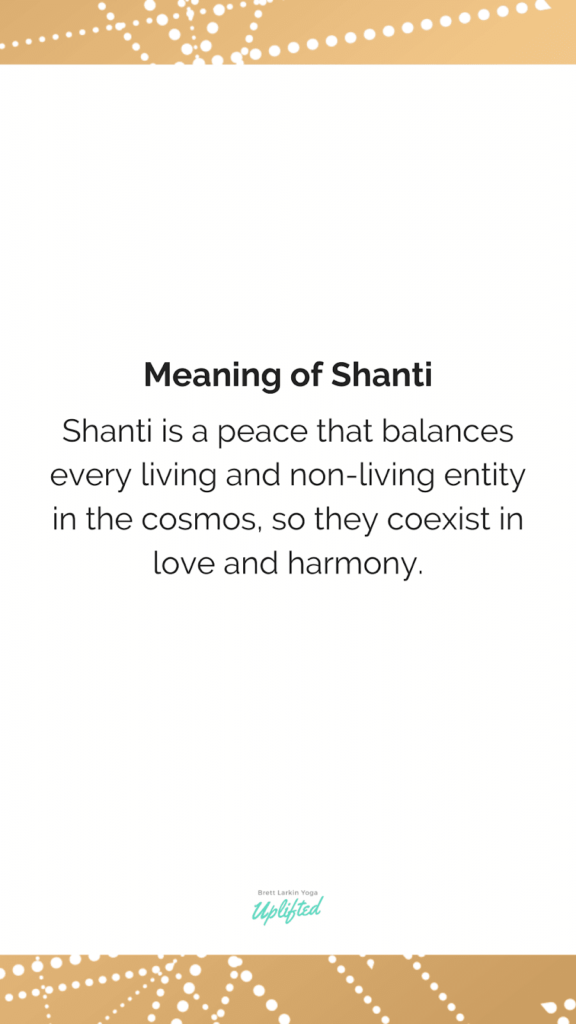
Many yogis chant the ‘om’ mantra to aid their meditation practice. But have you heard of the “om shanti” mantra? With regular practice and improved focus, this mantra is known to help yogis attain their ultimate goal—detachment from the outside world and eternal inner peace.
In this article, we will be covering the following topics:
- What does om shanti mean?
- When is the om shanti shanti shanti mantra chanted?
- How is the om shanti mantra different from the other yogic mantras?
- Why is shanti uttered three times?
Let’s begin by taking a closer look at the roots of the “Om shanti, shanti, shanti” mantra to get a better grasp of how it can help unite our body, mind, and soul and transform our life.
Hailing from India, Om shanti shanti shanti is a type of Shanti mantra; one of the most basic mantras in the Vedas. Chanting the Shanti mantra is known to invoke peace and tranquility in one’s soul as per Buddhist, Hindu, and Jain traditions.
As the mantra is made up of the words ‘om’ and ‘shanti’ let us start by exploring their origin , meaning, and significance.
The Word ‘Om’ (Oṃ)
According to Buddhist practices, which adopted mantra chanting from the Brahminical Hindu tradition from India, ‘om’ or ‘aum’ is considered the original sound—the one from which all the other sounds came to life.
It is said in Mandukya Upanishad (Vedic Sanskrit texts from India) that:
Aum, the word, is all this
This ancient Hindu text, authored in Sanskrit elaborates upon the meaning of om this way:
Om! — This syllable is this whole world.
It explains the meaning of om further by pointing out that:
The past, the present, the future—everything is just the word Om.
Not only is om the original universal sound, but also the original sound of the universe. It is the reality that symbolizes what has been, what is, and what will be.
Om is nothing and everything, the beginning and the end, the original and the Maya, the good and the bad, the storm and the peace, the happiness and the sorrow. It signifies the time that our mind perceives as normal and the timelessness our soul experiences when it is awakened through enlightenment.
Some dictionaries even compare om to the word ‘Amen’, as it is often translated from Sanskrit to English as “yes, verily, so be it”. Just like Amen, om is often uttered at the beginning and end of some Hindu ceremonies or while the Vedas are being read.
Another interesting fact to note is that om initially surfaced in the Upanishads as a lone Sanskrit monosyllable and then transcended into an entity that contains the meaning of the whole universe within, encompassing the good and the bad, the past and the present in a single utterance.
Though in the Hindu texts, even the individual sounds A, U, M are uttered with respect, given their spiritual attribution to the word om, the Buddhist texts do not use ‘om’ and ‘aum’ interchangeably.
The Word ‘Shanti’ (Śānti)
Next, let’s move on to the second part of the mantra in question; the word ‘shanti’. Simply put, shanti means “peace”. It is a beautiful word that sounds poetic and serene at the same time. The word shanti holds within it everything a yogi yearns to attain in their lifetime—uninterrupted peace, tranquility, and bliss until they finally become one with the Divine.
It is the kind of peace that envelops our body, mind, and everything around us—the people, the animals, the plants, the soil, the sky, the rain, the wind—a peace that balances every living and non-living entity in the cosmos, so they coexist in love and harmony.
Solely knowing what shanti means is not going to help us attain it. We need to train our body and mind to find peace within ourselves. An effective way to achieve inner peace is by practicing mindful meditation.
In Buddhism, “shanti” means the peace one finds in their soul, not outside their body.
This happens when our thought processes and emotions are in harmony with each other and we are in control of our responses and reactions. It is possible to attain this ultimate peace by meditating every day—mindful meditation can help us grow spiritually and detach ourselves from the worldly troubles that are trivial in the face of the universe.
Why Do We Say “Om Shanti” Three Times?
Why do yogis chant om shanti exactly three times? Why is it not two times or four times?
It is said in ancient yogic texts that when chanted thrice, the om shanti mantra can invoke spiritual peace and tranquility within ourselves. The number ‘three’ signifies the threefold effect this mantra has on our body, mind, and speech.
Another interpretation states how chanting om shanti three times can help us attain peace on the three levels of consciousness—when we are awake, when we are asleep, and when we are dreaming.
Om shanti shanti shanti or om shanti alone, are considered to be effective prayers when practicing yoga or meditation, as they help us reach out to the Divine for spiritual peace and protection from the world around us.
How to Pronounce “Om Shanti”
Now, let’s take a look at how to recite the “Om shanti shanti shanti” mantra the right way.
The “o” should be drawn out, and sound like the “/ɔː/” in the word “ore”. And the “a” and “t” in the word shanti should sound like the “ɑː” and “ð” in “father” respectively. Make sure the om resonates through your entire body and the “ɑː” of shanti is elongated for at least two beats.
The om shanti mantra also has another variation in which it is chanted as om shanti om. Here, the shanti is uttered only once and is shortly followed by om again.
Om Shanti Meaning in Yoga
Om shanti shanti shanti is usually chanted for spiritual growth during yoga practice or meditation. But it can also be chanted for peace in general if you are a spiritual aspirant.
It is believed that om shanti is chanted thrice in yoga not just for emphasis but also to address the three types of conflicts that are prevalent in the universe—the mental distress related to the divine (adhi-daivikam), the disturbances related to the world (adhi-bhautikam), and the problems related to the self (adhyatmikam).
Let us take a detailed look at what each of these means:
- Adhi-daivikam: Here, the mantra is chanted to help attain peace from “godsent” disturbances we cannot foresee or prevent. These disturbances can come in different forms—storms, hurricanes, volcanic eruptions, earthquakes, floods, diseases, accidents. When the first “shanti” is uttered, it is to invoke peace from problems that are beyond our control.
- Adhi-bhautikam: Here, the shanti mantra is meant to grant us peace from the problems caused by the people or things around us, i.e., the world. This can be anything that disrupts our peaceful state of mind—different background noises, phones ringing, cars honking, people arguing, dogs barking—in this situation, we have some control over what is happening. So, the second “shanti” is meant to help us attain peace from the worldly disturbances.
- Adhyatmikam: Now comes the most powerful disturbance of them all—from ourselves. The problems with our mind, body, or spirit are well within our control, but it is quite difficult to tame them at the same time. Adhyatmikam could mean anything that takes root inside us and disturbs our peace of mind—anger, jealousy, lust, greed, hatred—all of these disturbances originate from our ego and attachment. So, the third “shanti” is uttered to request the Divine for the power to replace all these unwanted feelings with peace, detachment, love, and tranquility.
To sum up, the first time, the chant is directed at the unseen forces, the second time at the direct surroundings, and the third time at ourselves.
Once we attain peace from all three types of disturbances, we will be able to focus solely on our soul, without any thought, emotion, or actions from others deterring us from the path of enlightenment. This is why the Om shanti shanti shanti mantra is considered one of the most powerful mantras in yogic practice.
How To Use The Om Shanti Mantra In Your Daily Practice

Thinking of giving om shanti shanti shanti mantra a try? Here is a simple and effective guide to get you going. If you are new to yoga, don’t worry, this mantra can be practiced by amateurs and professionals alike. If you have a set yoga routine, then you can start or end your practice with the om shanti mantra.
- Sit cross-legged on the floor with your back straight.
- Inhale peace and discard all the negative thoughts within you with an exhalation.
- Chant “Om shanti shanti shanti”. Elongate each word as much as you can. Feel the resonation move from your throat chakra to your heart chakra to your solar plexus chakra.
- Take a deep breath once again to inhale peace and exhale negativity.
- Repeat this chant five times.
- With each repetition of shanti, be mindful of the silence that follows, as this represents the true peace within you. For example, it should sound like “om…shanti…shanti…shantihi…”. Each pause, every breath, should resonate with the peaceful state of your soul.
- Wrap it up with an exhalation before moving on to your yoga asanas or meditation.
- Keep in mind that practicing this routine every day can give you the best results.
- With time, you can increase the number of chants or sustain the length of each utterance much longer.
Tips to remember:
- Get the guidance of a yoga teacher or listen to credible online sources to make sure you sound right when uttering the mantra.
- Be mindful of what the mantra means while chanting it. They are not mere words, but powerful prayers.
- Many people find it easier to concentrate when chanting in a tune—get creative, find the tune that works best for you.
You could even try a variation of the mantra with the “om shanti om” version, where “shanti” is not repeated thrice. This version is popularly used by yogis during daily meditation.
It is said that yogis can attain peace only when they come to terms with their true selves. The moment they know the difference between what is real and what is Maya, they would get closer to becoming one with the ultimate being. It is in this moment that they break free of every thought, every desire, every emotion that holds them back.
Once they cross this threshold of spiritual growth, neither the actions of others nor what they say can affect a yogi—because they have entered a new, complex realm of thought.
The only catch is that you never know when you will attain this state of mind. It may either take a few weeks or many decades—it all depends on your concentration and determination. But this does not mean it is an impossible feat; like every other challenge you face in life, this too can be overcome with time and practice, until you finally reach the epitome of peace.
Just remember to clear your mind, focus well, and give it your best shot. Who knows, eternal peace might just be an “om shanti shanti shanti” away.
Feel free to ask questions or leave comments about anything else you would like to know about the om shanti mantra and the journey towards peace. Do let me know how your first attempt went.
Take care and stay safe.
Hope you have a wonderful year ahead.
Next Steps
- Check out my YouTube channel and find some yoga classes that you can try out for yourself!
- Download my Yoga Calendars for an at-home practice, guided by me on YouTube!
- Join Uplifted for exclusive content that you can access right from the app. Take a deep dive into your practice with me this year!
Experience 3 Training Videos from Inside My 200-Hour Online YTT

YOU MIGHT ALSO LIKE
- What is Kriya Yoga? The Philosophy and Practice
- Uddiyana Bandha: Tapping Into Your Deep Core
- 4 Reasons Hasta Bandha Is Essential To Your Yoga Practice
- Vitarka Mudra: What It Is and How Do You Use It?
- Shakti Mudra: What It Is and How Do You Do It?
- Garuda Mudra: What It Is and How Do You Use It?
- Kali Mudra: What It Is and How Do You Do It?
- Shunya Mudra: What It Is and How Do You Do It?
- Varuna Mudra: What It Is and How Do You Use It?
- Vayu Mudra: What It Is and How Do You Use It?
- Samana Vayu: The Energy of Balance & How to Access It
- Apana Vayu: The Energy of Release & Surrender
- Udana Vayu: The Ascending Wind
- Prana Vayu: The Breath of Vitality
- Vyana Vayu: The Energetic Secret to Flow
Learn how to do 11 of the most popular yoga poses correctly. Free video + PDF download.















